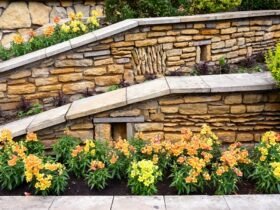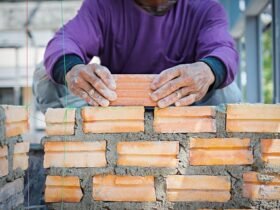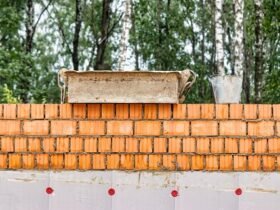Retaining walls are essential in managing slopes and creating usable space in landscapes. Advances in technology and innovation have revolutionized the design, construction, and performance of retaining walls. This guide explores advanced systems that integrate technology to enhance stability, durability, and environmental sustainability.
Modular Retaining Wall Systems
Modular retaining wall systems utilize pre-manufactured blocks or panels that interlock to create a stable structure. These systems offer versatility and ease of installation, making them popular choices for various applications:
- Interlocking Design: Modular blocks or panels fit together like puzzle pieces, minimizing the need for mortar and simplifying construction. This design also allows for easy repair and replacement of individual units without dismantling the entire wall.
- Variety of Materials: Available in concrete, stone, and composite materials, modular retaining walls provide aesthetic options to complement any landscape design. Each material has its own set of benefits:
- Concrete: Durable, versatile, and available in various finishes and colors.
- Stone: Natural and aesthetically pleasing, offering a timeless look.
- Composite: Lightweight, environmentally friendly, and resistant to weathering.
- Quick Installation: Modular systems often allow for faster installation compared to traditional methods, reducing labor costs and project timelines. The simplicity of the interlocking design makes it accessible to both DIY enthusiasts and professional installers.
- Cost-Effectiveness: Due to their ease of installation and the reduced need for specialized labor, modular systems can be more cost-effective than traditional retaining wall construction methods.
- Structural Integrity: Despite their ease of installation, modular systems are engineered to provide significant structural integrity, capable of handling substantial loads and pressures.
Advanced Modular Retaining Wall Innovations: Recent advancements in modular retaining walls include self-draining systems that automatically manage hydrostatic pressure, and hybrid designs that combine the strength of concrete with the lightweight properties of composites. These innovations are particularly valuable in Australian conditions where temperature fluctuations and soil movement are common challenges.
Geogrid Reinforcement for Enhanced Stability

Geogrid reinforcement involves integrating high-strength polymer grids into soil layers behind retaining walls. This technique enhances stability and load-bearing capacity:
- Mechanism: Geogrids distribute lateral forces from soil pressure, reducing the risk of wall failure and extending service life. By interlocking with the soil, geogrids create a composite mass that behaves as a single, reinforced unit.
- Installation: Layers of geogrid are placed between compacted soil layers, anchoring into the retaining wall structure. The installation process includes precise placement and tensioning of the geogrids to ensure maximum effectiveness.
- Applications: Ideal for tall or heavily loaded walls, geogrid reinforcement improves performance in challenging soil conditions and seismic zones. It is also beneficial in areas with poor soil conditions, where traditional retaining walls may struggle.
- Environmental Benefits: Reduces the need for excessive excavation and backfill material, promoting sustainable construction practices. Geogrid reinforcement can also enhance the natural drainage of the soil, reducing hydrostatic pressure behind the wall.
- Material Varieties: Geogrids come in various materials, including polyester, polypropylene, and high-density polyethylene, each offering different strengths and durability to suit specific project needs.
Australian-Specific Considerations: When implementing geogrid reinforcement in Australia, special attention should be paid to local soil types (such as reactive clay soils common in many regions) and the potential for bushfire conditions that may affect material performance. Australian-made geogrid products are often specifically engineered for these local conditions.
Smart Retaining Walls with Integrated Sensors
Smart retaining walls incorporate sensor technology to monitor various parameters such as soil moisture, temperature, and structural movement. These systems offer real-time data for proactive maintenance and performance optimization:
- Sensor Types: Includes moisture sensors, strain gauges, tilt meters, and pressure transducers embedded within the retaining wall structure. Each type of sensor provides specific data critical for maintaining wall integrity.
- Data Analysis: Provides continuous monitoring of wall conditions, alerting stakeholders to potential issues before they escalate. Advanced algorithms can analyze data trends to predict potential failures and recommend preventive measures.
- Remote Access: Enables remote monitoring and data access via mobile apps or web platforms, facilitating timely decision-making. This feature is particularly useful for large-scale projects or walls in remote locations.
- Predictive Maintenance: Predicts maintenance needs based on data trends, optimizing wall performance and longevity. By addressing issues before they become critical, property owners can avoid costly repairs and extend the life of the retaining wall.
- Integration with Building Management Systems: Smart retaining walls can be integrated with broader building management systems to provide a comprehensive view of property health and maintenance needs.
Australian Smart Wall Case Study: A recent project in Brisbane implemented smart retaining wall technology along a steep residential property. The system detected abnormal soil moisture levels weeks before visible signs of movement appeared, allowing for preventative measures that saved an estimated $35,000 in potential repair costs. This demonstrates the growing value proposition of smart retaining technology in the Australian market.
Advances in Retaining Wall Construction Techniques
Innovative construction techniques contribute to the durability and aesthetic appeal of modern retaining walls:
- Segmental Construction: Utilizes precast concrete or stone blocks that interlock to form a cohesive wall system. Segmental walls are highly flexible and can be designed to fit various site conditions and aesthetic preferences.
- Dry Stack Construction: This method involves stacking blocks without mortar, relying on gravity and interlocking shapes for stability. It allows for natural drainage and flexibility in the wall structure.
- Reinforced Soil Techniques: Integrates geotextiles or geogrids with compacted soil layers to create stable earth-retaining structures. These techniques are particularly useful for large-scale projects and walls that need to withstand significant loads.
- Mechanically Stabilized Earth (MSE): This approach combines soil and reinforcing materials to create a composite structure that is both strong and flexible.
- Green Construction Practices: Incorporates sustainable materials and techniques to minimize environmental impact and enhance resilience. Examples include using recycled materials, locally sourced stones, and environmentally friendly binders.
- Living Walls: These walls integrate vegetation into their design, providing additional stability through root systems and enhancing biodiversity.
- Mechanical Stabilization: Implements mechanical anchors or soil nails to reinforce soil and resist lateral pressures effectively. This technique is particularly useful in steep or unstable terrains.
- Soil Nailing: Involves inserting steel rods into the slope or retaining wall to provide additional support and stability.
Advanced Modular Construction Techniques
The latest innovations in modular retaining wall construction include:
- Precision-Engineered Components: Modern modular systems use computer-designed components that ensure perfect fit and maximum structural integrity
- Hybrid Systems: Combining modular blocks with geogrid reinforcement creates walls that can withstand extreme conditions while maintaining aesthetic appeal
- Self-Locking Mechanisms: New generation modular blocks feature advanced interlocking systems that eliminate the need for adhesives while providing superior stability
- Integrated Drainage: Many modern modular systems now incorporate built-in drainage channels that manage water flow more effectively than traditional methods
Future Trends in Retaining Wall Design and Materials

The evolution of retaining wall design is influenced by advancements in materials, sustainability goals, and innovative construction methods:
- Composite Materials: Emerging materials like recycled plastics and composites offer durability and environmental benefits. These materials are often lighter, more resistant to weathering, and easier to work with than traditional options.
- Recycled Plastic Blocks: Made from post-consumer plastics, these blocks are environmentally friendly and highly durable.
- Fiber-Reinforced Polymers (FRP): These composites offer high strength-to-weight ratios and are resistant to corrosion and environmental degradation.
- Integration with Landscape: Designs that blend retaining walls seamlessly into landscapes, incorporating greenery and functional elements. This approach enhances the aesthetic appeal and ecological value of the site.
- Terracing: Creating multi-level terraces with retaining walls to optimize space and integrate with the natural landscape.
- Vertical Gardens: Incorporating plants directly into the wall structure to create living, breathing landscapes.
- Smart Infrastructure: Continued integration of IoT (Internet of Things) sensors and data-driven design for smart, adaptive structures. This technology enables walls to respond dynamically to environmental changes.
- Adaptive Walls: Retaining walls that can adjust their structure or drainage capabilities in response to real-time data.
- Climate Resilience: Designs that account for climate change impacts, including increased rainfall, temperature fluctuations, and extreme weather events.
- Permeable Walls: Designed to allow water to pass through, reducing hydrostatic pressure and improving drainage.
- Heat-Resistant Materials: Using materials that can withstand higher temperatures and UV exposure without degrading.
The Future of Modular Retaining Walls
Modular retaining wall technology is advancing rapidly, with several exciting developments on the horizon:
- 3D-Printed Modular Components: Emerging technology allows for custom 3D-printed retaining wall blocks that can be tailored to specific site requirements and aesthetic preferences
- Self-Healing Materials: New concrete formulations with microcapsules of healing agents that automatically repair small cracks, extending wall lifespan
- Solar-Integrated Walls: Modular systems that incorporate photovoltaic technology to generate renewable energy while serving their primary function
- AI-Optimized Designs: Machine learning algorithms that analyze site conditions to recommend optimal modular configurations for maximum stability and cost-efficiency
FAQs about Advanced Retaining Wall Systems
Modular retaining wall systems offer quicker installation, design flexibility, and often cost-effectiveness compared to poured concrete walls. They are suitable for various soil conditions and can be installed by DIY enthusiasts or professionals. Traditional poured concrete walls, while highly durable, require more extensive labor and longer curing times.
Geogrid reinforcement enhances stability by distributing forces within the soil mass. It reduces the risk of wall failure, extends service life, and minimizes excavation requirements, making it suitable for challenging soil conditions. Geogrids also improve the overall structural integrity of the retaining wall.
Smart retaining walls provide real-time data on wall conditions, enabling proactive maintenance and optimizing performance. They offer remote monitoring capabilities, predictive maintenance insights, and potential cost savings on repairs. Property owners can address issues before they escalate, ensuring the longevity and safety of the retaining wall.
Eco-friendly practices include using recycled materials, minimizing excavation, promoting drainage efficiency, and integrating vegetation for natural erosion control. These practices reduce environmental impact and support sustainable development goals. Additionally, using local materials can reduce transportation emissions and support the local economy.
Future trends include the use of advanced materials like composites, integration with smart technologies for enhanced functionality, and designs that prioritize climate resilience and aesthetic integration with natural landscapes. Innovations in construction techniques and materials continue to push the boundaries of what retaining walls can achieve.
Work with a licensed contractor who is familiar with local building codes and permit requirements. Ensure all materials and construction techniques comply with structural safety standards and environmental regulations. Regular inspections and adherence to best practices are essential for compliance and safety.
Consider factors such as durability, aesthetic appeal, environmental impact, and cost. Materials like concrete and stone offer high durability, while composites and recycled materials provide eco-friendly options. The choice of materials should align with your specific needs, site conditions, and design preferences.
Advanced Modular Retaining Wall FAQs
Advanced modular retaining walls incorporate cutting-edge features like self-draining systems, hybrid material compositions, and precision-engineered interlocking mechanisms. These innovations provide superior performance in challenging conditions while maintaining the ease of installation that makes modular systems appealing.
Absolutely. Modern advanced modular systems are engineered to meet commercial-grade requirements, with many systems capable of supporting significant loads while offering design flexibility. Their quick installation can also minimize disruption to commercial operations during construction.
With proper installation and maintenance, advanced modular retaining walls can last 50 years or more. Many manufacturers now offer extended warranties (25+ years) on their premium modular systems, reflecting confidence in their long-term performance.
Conclusion
By leveraging advanced technology and innovative construction techniques, today’s retaining walls not only address functional needs but also contribute to sustainable development and enhanced landscape aesthetics. Whether selecting modular systems, incorporating geogrid reinforcement, or embracing smart technologies, informed decision-making ensures a retaining wall that meets both current needs and future challenges.
For Australian property owners and developers, advanced modular retaining walls represent a particularly compelling solution, combining the durability needed for our unique climate with the flexibility to handle our diverse soil conditions. As technology continues to evolve, these systems will only become more sophisticated, offering even greater value and performance for landscape projects across the country.










